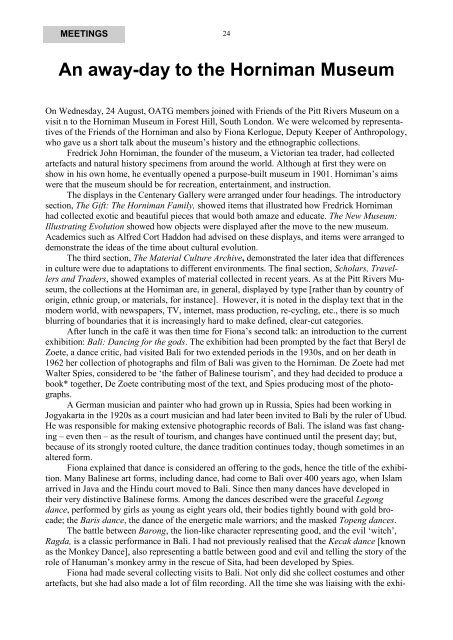ASIAN TEXTILES - OATG. Oxford Asian Textile Group
ASIAN TEXTILES - OATG. Oxford Asian Textile Group
ASIAN TEXTILES - OATG. Oxford Asian Textile Group
- No tags were found...
You also want an ePaper? Increase the reach of your titles
YUMPU automatically turns print PDFs into web optimized ePapers that Google loves.
MEETINGS24An away-day to the Horniman MuseumOn Wednesday, 24 August, <strong>OATG</strong> members joined with Friends of the Pitt Rivers Museum on avisit n to the Horniman Museum in Forest Hill, South London. We were welcomed by representativesof the Friends of the Horniman and also by Fiona Kerlogue, Deputy Keeper of Anthropology,who gave us a short talk about the museum‘s history and the ethnographic collections.Fredrick John Horniman, the founder of the museum, a Victorian tea trader, had collectedartefacts and natural history specimens from around the world. Although at first they were onshow in his own home, he eventually opened a purpose-built museum in 1901. Horniman‘s aimswere that the museum should be for recreation, entertainment, and instruction.The displays in the Centenary Gallery were arranged under four headings. The introductorysection, The Gift: The Horniman Family, showed items that illustrated how Fredrick Hornimanhad collected exotic and beautiful pieces that would both amaze and educate. The New Museum:Illustrating Evolution showed how objects were displayed after the move to the new museum.Academics such as Alfred Cort Haddon had advised on these displays, and items were arranged todemonstrate the ideas of the time about cultural evolution.The third section, The Material Culture Archive, demonstrated the later idea that differencesin culture were due to adaptations to different environments. The final section, Scholars, Travellersand Traders, showed examples of material collected in recent years. As at the Pitt Rivers Museum,the collections at the Horniman are, in general, displayed by type [rather than by country oforigin, ethnic group, or materials, for instance]. However, it is noted in the display text that in themodern world, with newspapers, TV, internet, mass production, re-cycling, etc., there is so muchblurring of boundaries that it is increasingly hard to make defined, clear-cut categories.After lunch in the café it was then time for Fiona‘s second talk: an introduction to the currentexhibition: Bali: Dancing for the gods. The exhibition had been prompted by the fact that Beryl deZoete, a dance critic, had visited Bali for two extended periods in the 1930s, and on her death in1962 her collection of photographs and film of Bali was given to the Horniman. De Zoete had metWalter Spies, considered to be ‗the father of Balinese tourism‘, and they had decided to produce abook* together, De Zoete contributing most of the text, and Spies producing most of the photographs.A German musician and painter who had grown up in Russia, Spies had been working inJogyakarta in the 1920s as a court musician and had later been invited to Bali by the ruler of Ubud.He was responsible for making extensive photographic records of Bali. The island was fast changing– even then – as the result of tourism, and changes have continued until the present day; but,because of its strongly rooted culture, the dance tradition continues today, though sometimes in analtered form.Fiona explained that dance is considered an offering to the gods, hence the title of the exhibition.Many Balinese art forms, including dance, had come to Bali over 400 years ago, when Islamarrived in Java and the Hindu court moved to Bali. Since then many dances have developed intheir very distinctive Balinese forms. Among the dances described were the graceful Legongdance, performed by girls as young as eight years old, their bodies tightly bound with gold brocade;the Baris dance, the dance of the energetic male warriors; and the masked Topeng dances.The battle between Barong, the lion-like character representing good, and the evil ‗witch‘,Ragda, is a classic performance in Bali. I had not previously realised that the Kecak dance [knownas the Monkey Dance], also representing a battle between good and evil and telling the story of therole of Hanuman‘s monkey army in the rescue of Sita, had been developed by Spies.Fiona had made several collecting visits to Bali. Not only did she collect costumes and otherartefacts, but she had also made a lot of film recording. All the time she was liaising with the exhi-
















